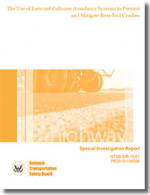The Use of Forward Collision Avoidance Systems to Prevent and Mitigate Rear-End Crashes
The National Transportation Safety Board’s investigation found that currently available forward collision avoidance technologies for passenger and commercial vehicles still show clear benefits that could reduce rear-end crash fatalities.
Over the past 3 years, the National Transportation Safety Board (NTSB) has investigated nine rear-end accidents involving passenger or commercial vehicles striking the rear of another vehicle - the result of which was 28 fatalities and 90 injured people.
In 2012, rear-end crashes resulted in 1,705 fatalities and represented almost half of all two-vehicle crashes.
This Special Investigation Report reviews the previous recommendations made by the NTSB pertaining to the reduction of rear-end crashes and examines recent collision avoidance technologies that would aid in their prevention.
The report concludes that collision warning systems, particularly when paired with active braking, could significantly reduce the frequency and severity of rear-end crashes.
The report issues six new recommendations - four to the National Highway Traffic Safety Administration (NHTSA) and two to vehicle manufacturers, both passenger and commercial.
In addition, it reiterates two recommendations to NHTSA and reclassifies four recommendations previously issued to NHTSA.
What’s Related

Favorites





